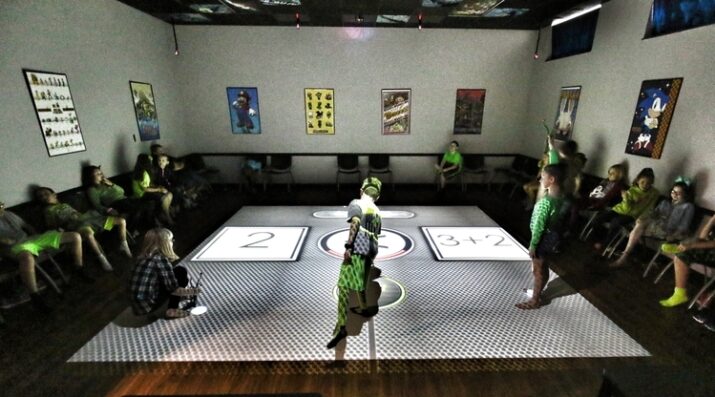Beyond Test Scores, Measuring the Impact of SMALLab on Student Leadership
Topics

Educators often take advantage of educational technologies as they make the shifts in instruction, teacher roles, and learning experiences that next gen learning requires. Technology should not lead the design of learning, but when educators use it to personalize and enrich learning, it has the potential to accelerate mastery of critical content and skills by all students.
A SMALLab Q&A with Tracy Williams, K-6 Technology Coach
SMALLab Learning CEO, Dr. David Birchfield sits down with Tracy Williams, Technology Coach and SMALLab instructor at Bobtown Elementary School, to discuss William’s process for evaluating new technologies, and how Bobtown’s SMALLab creates leadership opportunities for students that are often unseen at home or in the classroom.
In the final article of a four-part series, SMALLab Learning CEO, Dr. David Birchfield, sits down with Tracy Williams, Technology Coach and SMALLab instructor at Bobtown Elementary School, a rural Pennsylvania school outside Pittsburgh. They discuss William’s process for evaluating new technologies, and how Bobtown’s SMALLab creates leadership opportunities for students that are often unseen at home or in the classroom.
SMALLab is a learning company that partners with educators to transform learning. SMALLab is a room-sized, 3D collaborative learning environment. When students are learning in SMALLab they are out of their seats, moving around and working together to understand the lesson. Multiple research studies show that SMALLab yields an 86 percent increase in student learning, 6.7X increase in student collaboration, and a 33 percent increase in teacher effectiveness. Learn more about SMALLab on its NGLC grantee page or at the SMALLab site.

Dr. Birchfield: Tell me about Bobtown Elementary School and your students.
Williams: Bobtown Elementary School is a K-6 school, with approximately 350 students, located in a rural area outside of Pittsburgh. I administer our SMALLab, which is utilized across each of our grade levels. Our students come to me once a week for 40 minutes, so I have the opportunity to work with every student at the school, and every student has the opportunity to experience the SMALLab.
Dr. Birchfield: You administer not just your SMALLab, but a computer lab as well. As an advocate of technology, what do you look for in a new technology investment for the school?
Williams: The traditional classroom asks all students, regardless of skill level, to learn in the same way and at the same pace. This may be efficient from the standpoint of the educator, but it’s not effective for the student. I’m a firm believer that every student learns differently, and as a technology advocate, it’s my responsibility to investigate new tools for acquiring, understanding, and retaining the concepts covered in their classrooms.
Specifically, I look for three things:
First, the solution should have a proven track record of improving student outcomes across the entire curriculum—not just in math, but in language arts as well.
Second, the solution must reinforce and improve retention of topics taught in the classroom. It has to enhance the classroom experience, not replace it.
Third, the solution has to make the learning environment fun, interactive, and collaborative.
Dr. Birchfield: In terms of making the learning environment fun, interactive, and collaborative, what are some of the most popular SMALLab scenarios?
Williams: The three scenarios that we use the most are Memory, Order Line, and Venn Diagrammer. I break up the classes into two teams. The students really like to compete, and these scenarios are the best for that. Memory is my favorite, though, and the kids love it, too. Sometimes, I’ll divide the class into 2 teams and have students take turns to make a match. I’ll use my SmartBoard to keep track of which team is the fastest.
If I’m teaching something like fractions, I’ll then use Order Line to see who can get fractions in order the fastest.
Dr. Birchfield: How does coordination with the classroom teachers work? Is it going well from the students’ standpoint?
Williams: It’s important that we have the scenarios ready to go each week, so I’m communicating with the classroom teachers on a regular basis to make sure I know what they’re working on. Right now, I’m focusing a lot on multiplication and division because—with the adoption of the Common Core—our math scores on the annual school assessment exam have been down.
From the students’ standpoint, they just love it. They’re constantly asking their teachers, “When can we get on the mat?” They’re not just sitting in chairs in the SMALLab. They’re getting up and moving around. They love that aspect of the learning experience, and it’s why they’re so engaged with it.
Dr. Birchfield: Tell me about the impact of your SMALLab. What is it doing for the students?
Williams: The students are definitely paying attention more, and that’s because of how engaging our SMALLab is. It covers the same lessons as the classroom, but it allows students to approach those lessons in a much more effective way. Many of the activities are also student-led. I work as a facilitator, but our SMALLab teaches students to work through challenges on their own. I’m able to take a step back and let the student leaders emerge and guide others.
Dr. Birchfield: What does student leadership look like in your SMALLab?
Williams: In addition to giving students more time—and a new means—to master a topic, students also develop social skills by working collaboratively with their classmates to work through the scenarios. As I said, by using the SMALLab, the instructor becomes more of a facilitator. We’re seeing things emerge that don’t happen in the traditional classroom and that often isn’t even witnessed at home. I have the perfect example. In kindergarten, one of the boys (who is typically very quiet) ended up leading two other students in his group during the Order Line scenario—basically explaining to them how to play the game and how to play it properly. I mentioned this to his mother, and even she hadn’t seen that sort of leadership from him yet.
Dr. Birchfield: What does the future look like for Bobtown Elementary School and for your SMALLab?
Williams: I’m most excited about the new scenarios that are forthcoming, especially those for Pre-K. These will only serve to better prepare students entering Bobtown, and they’ll also broaden how we use our SMALLab for the rest of our students. The future is bright at Bobtown Elementary School. It’s brighter because of our SMALLab.
Related Posts in the SMALLab Educator Q&A Series:
- Teaching the Whole Child Utilizing Collaborative Learning Spaces, a Q&A with the executive director of Grande Innovation Academy near Phoenix
- Improving Fraction Education, a Q&A with a math teacher at Twin Rivers Intermediate School in McKeesport, PA
- Bridging the Wealth Gap, a Q&A with the superintendent of Connellsville Area School District in Pennsylvania




